MPETITION in the haulage business is 'ening. More goods have
Page 57
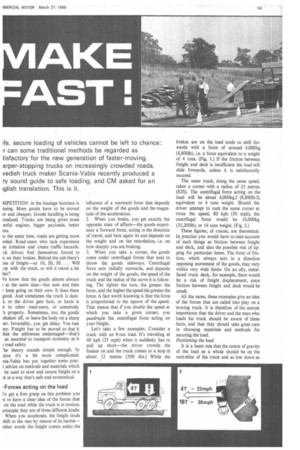
Page 58
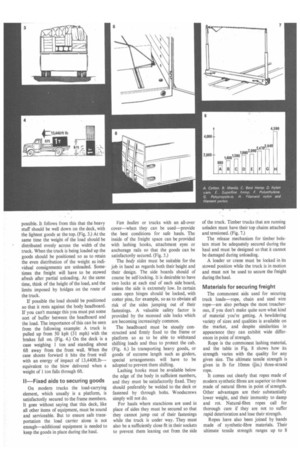
Page 59
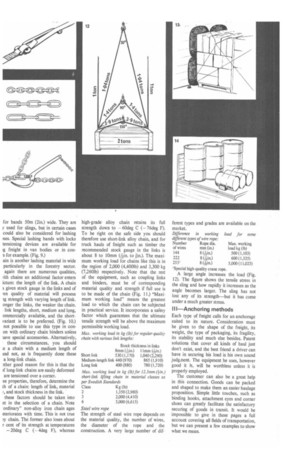
Page 60
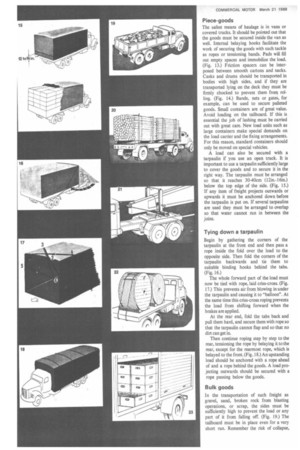
Page 61
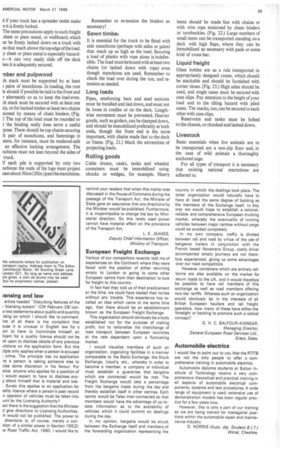
If you've noticed an error in this article please click here to report it so we can fix it.
to be moved er and cheaper. Goods handling is being onalized. Trucks are being given more terful engines, bigger payloads, better kes.
U the same time, roads are getting more wded. Road-users who lack experience se irritation and create traffic hazards. ck drivers find themselves forced to n on their brakes. Behind the cab there's ms of freight—or 10, 20, 30. . . . Will :op with the truck, or will it travel a bit her?
Ve know that the goods almost always r at the same time—but now and then r keep going on their own. It does them good. And sometimes the truck is dam1, or the driver gets hurt, or harm is
e to other road-users, or somebody 's property. Sometimes, too, the goods shaken off, or leave the body on a sharp ler. Invariably, you get delay. You lose ley. Freight has to be moved so that it :hes the addressee undamaged—that's as essential to transport economy as it r road safety.
'he theory sounds simple enough. In :Ike it's a bit more complicated. nia-Vabis has put together some praeadvice on methods and materials which be used to stow and secure freight on a :k in a way that's safe and economical.
-Forces acting on the load
Po get a firm grasp on this problem you
e to have a clear idea of the forces that on the load while the truck is in motion. principle they are of three different kinds: When you accelerate, the freight tends .1.1ift to the rear by reason of its inertia— other words the freight comes under the
influence of a rearward force that depends on the weight of the goods and the magnitude of the acceleration.
2. When you brake, you get exactly the opposite state of affairs—the goods experience a forward force, acting in the direction of travel, and here again its size depends on the weight and on the retardation, i.e. on how sharply you are braking.
3. When you take a corner, the goods come under centrifugal forces that tend to throw the goods sideways. Centrifugal force acts radially outwards, and depends on the weight of the goods, the speed of the truck and the radius of the curve it is following. The tighter the turn, the greater the force, and the higher the speed the greater the force. A fact worth knowing is that the force is proportional to the square of the speed. That means that if you double the speed at which you take a given corner, you quadruple the centrifugal force acting on your freight.
Let's take a few examples. Consider a truck with an 8-ton load. It's travelling at 40 kph (25 mph) when it suddenly has to pull up short—the driver crowds the brake t on and the truck comes to a stop in about 12 metres (39ft 4in.) While the brakes are on the load tends to shift forwards with a force of around 4,000kg (8,8001b), i.e. a force equivalent to a weight of 4 tons. (Fig. 1.) If the friction between freight and deck is insufficient the load will slide forwards, unless it is satisfactorily secured.
The same truck, doing the same speed, takes a corner with a radius of 25 metres (82ft). The centrifugal force acting on the load will be about 4,000kg.f (8,8001b.f), equivalent to 4 tons weight. Should the driver attempt to rush the same corner at twice the speed, 80 kph (50 mph), the centrifugal force would be 16,000kg (35,2001b), or 16 tons weight. (Fig. 2.) These figures, of course, are theoretical. In practice you would have to take account of such things as friction between freight and deck, and also the possible risk of tipping for particular items. The force of friction, which always acts in a direction opposing movement of the goods, may vary within very wide limits. On an oily, metalfaced truck deck, for example, there would be a risk of freight displacement, since friction between freight and deck would be small.
All the same, these examples give an idea of the forces that are called into play on a moving truck. It is therefore of the utmost importance that the driver and the man who loads his truck should be aware of these facts, and that they should take great care in choosing materials and methods for securing the load.
Positioning the load It is a basic rule that the centre of gravity of the load as a whole should be on the eentitline of the truck and as low down as possible. It follows from this that the heavy stuff should be well down on the deck, with the lightest goods at the top. (Fig. 3.) At the same time the weight of the load should be distributed evenly across the width of the truck. When the truck is being loaded up the goods should be positioned so as to retain the even distribution of the weight as individual consignments are unloaded. Sometimes the freight will have to be stowed afresh after partial unloading. At the same time, think of the height of the load, and the limits imposed by bridges on the route of the truck.
If possible the load should be positioned so that it rests against the body headboard. If you can't manage this you must put some sort of buffer between the headboard and the load. The importance of this can be seen from the following example: A truck is pulled up from 50 kph (31 mph) with the brakes full on. (Fig. 4.) On the deck is a case weighing 1 ton and standing about 611 away from the front wall. When the case shoots forward it hits the front wall with an energy of impact of 13,440ft.lbequivalent to the blow delivered when a weight of 1 ton falls through 611.
I—Fixed aids to securing goods
On modern trucks the load-carrying element, which usually is a platform, is satisfactorily secured to the frame members. It goes without saying that this deck, like all other items of equipment, must be sound and serviceable. But to ensure safe transportation the load carrier alone is not enough—additional equipment is needed to keep the goods in place during the haul.
Van bodies or trucks with an all-over cover—when they can be used—provide the best conditions for safe hauls. The inside of the freight space can be provided with lashing hooks, attachment eyes or anchorage rails so that the goods can be satisfactorily secured. (Fig. 5.) The body sides must be suitable for the job in hand as regards both their height and their design. The side boards should of course be self-locking. It is desirable to have two locks at each end of each side board, unless the side is extremely low. In certain cases open hinges should be locked, with cotter pins, for example, so as to obviate all risk of the sides jumping out of their fastenings. A valuable safety factor is provided by the recessed side locks which are becoming increasingly common.
The headboard must be stoutly constructed and firmly fixed to the frame or platform so as to be able to withstand shifting loads and thus to protect the cab. (Fig. 6.) In transporting heavy goods, or goods of extreme length such as girders, special arrangements will have to be adopted to prevent them shifting.
Lashing hooks must be available below the edge of the body in sufficient numbers, and they must be satisfactorily fixed. They should preferably be welded to the deck or fastened by through bolts. Woodscrews simply will not do.
For hauls where stanchions are used in place of sides they must be secured so that they cannot jump out of their fastenings while the truck is under way. They must also be a sufficiently close fit in their sockets to prevent them leaning out from the side of the truck. Timber trucks that are running unladen must have their top chains attached and tensioned. (Fig. 7.) The release mechanism for timber bolsters must be adequately secured during the haul and must be designed so that it cannot be damaged during unloading.
A loader or crane must be locked in its stowed position while the truck is in motion and must not be used to secure the freight during the haul.
Materials for securing freight The commonest aids used for securing truck loads—rope, chain and steel wire rope—am also perhaps the most treacherous, if you don't make quite sure what kind of material you're getting. A bewildering variety of sizes and qualities is available on the market, and despite similarities in appearance they can exhibit wide differences in point of strength.
Rope is the commonest lashing material, and the table in Fig. 8 shows how its strength varies with the quality for any given size. The ultimate tensile strength is given in lb for lOmm (iin.) three-strand rope.
It comes out clearly that ropes made of modern synthetic fibres are superior to those made of natural fibres in point of strength. Other advantages are their substantially lower weight, and their immunity to damp and rot. Natural-fibre ropes call for thorough care if they are not to suffer rapid deterioration and lose their strength.
Ropes have also been joined by bands made of synthetic-fibre materials. Their ultimate tensile strength ranges up to 8 for bands 50m (2in.) wide. They are v used for slings, but in certain cases could also be considered for lashing )ses. Special lashing bands with locks tensioning devices are available for ig freight in van bodies or in cons for example. (Fig. 9.) am n is another lashing material in wide particularly in the forestry sector. again there are numerous qualities, rich chains an additional factor enters icture: the length of the link. A chain given stock gauge in the links and of ren quality of material will possess ig strength with varying length of link. onger the links, the weaker the chain. link lengths, short, medium and long, omrnercially available, and the shortvariant is to be preferred. (Fig. 10.) not possible to use this type in conon with ordinary chain binders unless lave special accessories. Alternatively, these circumstances, you should c a chain with a medium length of Ind not, as is frequently done these a long-link chain.
)ther good reason for this is that the if long-link chains are easily deformed are tensioned over a corner.
ee properties, therefore, determine the th of a chain: length of link, material t, and stock thickness in the link.
these factors should be taken into nt in the selection of a chain. Note ordinary" non-alloy iron chain ages eteriorates with time. This is not true chain. The former also loses about r cent of its strength at temperatures — 20deg C (— 4deg F), whereas
high-grade alloy chain retains its full strength down to — 60deg C (-76deg F). To be right on the safe side you should therefore use short-link alloy chain, and for truck hauls of freight such as timber the recommended stock gauge in the links is about 8 to lOmm (bin. to fin.). The maximum working load for chains like this is in the region of 2,000 (4,4001b) and 3,300 kg (7,2601b) respectively. Note that the rest of the equipment, such as coupling links and binders, must be of corresponding material quality and strength if full use is to be made of the chain (Fig. 11.) "Maximum working load" means the greatest load to which the chain can be subjected in practical service. It incorporates a safety factor which guarantees that the ultimate tensile strength will be above the maximum permissible working load.
Max. working load in kg (lb) for regular-quality chain with various link lengths:
The strength of steel wire rope depends on the material quality, the number of wires, the diameter of the rope and the construction. A very large number of dif Each type of freight calls for an anchorage suited to its nature. Consideration must be given to the shape of the freight, its weight, the type of packaging, its fragility, its stability and much else besides. Patent solutions that cover all kinds of haul just don't exist, and the best friend a driver can have in securing his load is his own sound judgment. The equipment he uses, however good it is, will be worthless unless it is properly employed.
The customer can also be a great help in this connection. Goods can be packed and shaped to make them an easier haulage proposition. Simple little touches, such as binding hooks, attachment eyes and corner shoes can greatly facilitate the satisfactory securing of goods in transit. It would be impossible to give in these pages a full account covering all fields of transportation, but we can present a few examples to show what we mean. Piece-goods The safest means of haulage is in vans or covered trucks. It should be pointed out that the goods must be secured inside the van as well. Internal belaying hooks facilitate the work of securing the goods with such tackle as ropes or tensioning bands. Pads will fill out empty spaces and immobilize the load. (Fig. 13.) Friction spacers can be interposed between smooth cartons and sacks. Casks and drums should be transported in bodies with high sides, and if they are transported lying on the deck they must be firmly chocked to prevent them from rolling. (Fig. 14.) Bands, nets or gates, for example, can be used to secure palleted goods. Small containers are of great value. Avoid loading on the tailboard. If this is essential the job of lashing must be carried out with great care. New load units such as large containers make special demands on the load carrier and the fixing arrangements. For this reason, standard containers should only be moved on special vehicles.
A load can also be secured with a tarpaulin if you use an open truck. It is important to use a tarpaulin sufficiently large to cover the goods and to secure it in the right way. The tarpaulin must be arranged so that it reaches 30-40cm (12in.-16in.) below the top edge of the side. (Fig. 15.) If any item of freight projects outwards or upwards it must be anchored down before the tarpaulin is put on. If several tarpaulins are used they must be arranged to overlap so that water cannot run in between the joins.
Tying down a tarpaulin Begin by gathering the corners of the tarpaulin at the front end and then pass a rope inside the fold over the load to the opposite side. Then fold the corners of the tarpaulin backwards and tie them to suitable binding hooks behind the tabs. (Fig. 16.) The whole forward part of the load must now be tied with rope, laid criss-cross. (Fig. 17.) This prevents air from blowing in under the tarpaulin and causing it to "balloon". At the same time this criss-cross roping prevents the load from shifting forward when the brakes are applied.
At the rear end, fold the tabs back and pull them hard, and secure them with rope so that the tarpaulin cannot flap and so that no dirt can get in.
Then continue roping step by step to the rear, tensioning the rope by belaying it to the rear, except for the rearmost rope, which is belayed to the front. (Fig..18.) An upstanding load should be anchored with a rope ahead of and a rope behind the goods. A load projecting outwards should be secured with a rope passing below the goods.
Bulk goods In the transportation of such freight as gravel, sand, broken rock from blasting operations, or scrap, the sides must be sufficiently high to prevent the load or any part of it from falling off. (Fig. 19.) The tailboard must be in place even for a very short run. Remember the risk of collapse,
if your truck has a spreader outlet make -e it is firmly locked.
The same precautions apply to such freight sheet or plate metal, or wallboard, which 1st be firmly lashed down on a truck with es that reach above the top edge of the load. y sheet or plate metal is especially hazards—it can very easily slide off the deck iess it is adequately secured.
.nber and pulpwood
:11 stack must be supported by at least ) pairs of stanchions. In loading, the root Is should if possible be laid to the front and r alternately so as to keep the load even. :h stack must be secured with at least one Lin, or for barked timber at least two chains sioned by means of chain binders. (Fig. ) The top of the load must be rounded so t the binding really does serve a useful -pose. There should be top chains securing '11 pair of stanchions, and fastenings in sters, for instance, must be rendered safe an effective locking arrangement. The nchions must not lean beyond the sides of truck.
if each pile is supported by only two nchions the ends of the logs must project east about 50cm (20i n.) past the stanchions.
























































































































